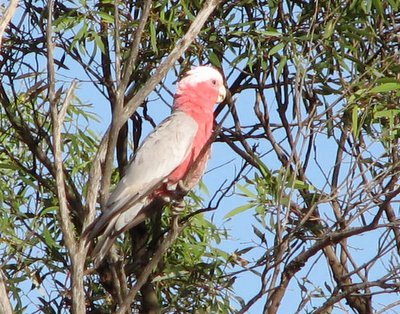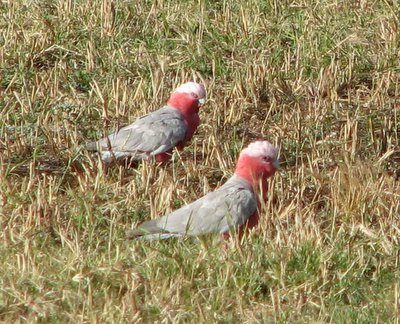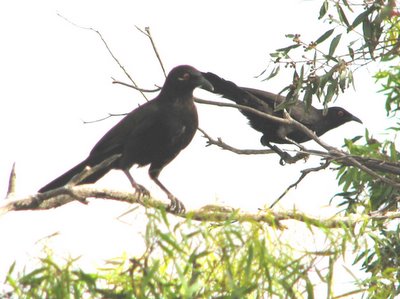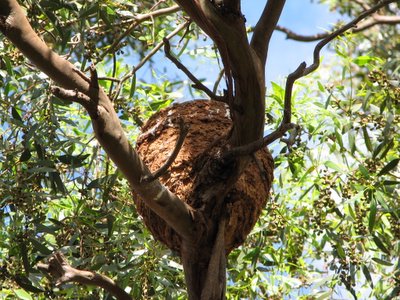Bushfire
Yesterday’s weather forecast promised northerly winds with a maximum temperature of 37 degrees Celsius. I decided to go for an hour long walk early in the morning to avoid the worst of the heat.
As far as birds were concerned I didn’t see anything out of the ordinary. Numbers seemed to be down by about 50% but this only indicates that they were not calling as much. On my local walks more than half of my bird identifications are by call alone.
I did get a good photograph of two – presumably a pair – of galahs sitting high in the dead branches of a mallee tree near the road.
I was intrigued by the rising sun lighting up the ruins of an old farmhouse less than a kilometre from our front gate. I am very pleased with this shot because it also shows up the thick mallee scrub behind it. During summer months I rarely venture up in that area for walks or bird watching because the few tracks through the area are so overgrown with weeds and grasses one cannot have warning of snakes. Little did I know that a few hours later this area would become an inferno.
Mid afternoon a bushfire broke out just behind this old farmhouse. As the afternoon passed the fire grew worse and by four o’clock, with the temperature around 42 degrees, we and our neighbours decided to pack some essential items in our cars and have them ready for a retreat. If the forecast cool change came early or the wind suddenly changed direction, our house was in a direct line of the fire.
We watched anxiosly for the next eight hours as about thirty fire crews, many from distant towns, battled the blaze. A helicopter constantly dropped water and three fire fighting fixed wing planes dropped fire retardant on the blaze. At midnight another twelve relief fire crews and their trucks came to the scene; some had travelled from as far as Pinnaroo, nearly two hours travel away.
After a restless few hours sleep we were awoken at 4:30am by the smell of smoke; the wind had finally changed. By then there were only a few spot fires visible from our window. This morning the cool change has been welcome relief. Several fire crews are still watching the area. Wisps of smoke can still be seen from a few hot spots. Mallee stumps and roots can smoulder for weeks if left unattended.
The main threat is now over, but the forecast for more hot weather over the next two days will keep us on edge. This, however, has been our only fire threat in over twenty years of living in this house.
Galahs in the morning sun
On my morning walks through the mallee scrubland and the nearby farming land I often come across or hear the beautiful Australian parrot, the Galah. This species is very common throughout most of Australia. They can often be observed in pairs or small flocks and occasionally very large flocks numbering several hundred.
On recent morning walks I have seen about 4 to 8 Galahs sitting on top of several wattle bushes (Acacia spp) on the side of the road I walk along. They are usually busy eating the seeds. The rising sun catches the brilliant colours of the breast feathers, lighting up the dull green leaves of the bush. On too many occasions I have not had my camera with me.
Yesterday I tried to creep up to get a good photograph. This little flock was very wary and flew off to some nearby mallee trees. I was able to zoom in sufficiently to get a reasonable shot of one of them.

In the paddock opposite there a few more Galahs busily searching for seeds in the grasses in the field. This is a common sight in Australian paddocks. Sometimes the ground seems to turn pink as hundreds of Galahs swoop down to the ground looking for a meal.
Chuffing around
On my morning walks in the hills to the west of Murray Bridge in South Australia I often come across family groups of White Winged Choughs (pronounced “chuffs”). These amusing birds are reasonably common throughout the mallee districts of our state. Their white wings are quite conspicuous when they are in flight.
White Winged Choughs are usually found in family groups of about four or five through to as many as fifteen and sometimes more. They are often seen foraging for food on the ground. We often watch them from our sun room or in our garden as they strut around with an important looking air. It amuses us that they seem to prefer walking to flying. When startled, they fly up to the nearest tree, their rasping alarm calls carrying far. At other times their calls can be mournful whistles.
White Winged Choughs make a large bowl shaped mud nest. Below is a photograph I took this morning in an area where I have often observed several groups of choughs. This particular nest did not seem to be in use at present. It looks quite new and was probably used in the spring time this year (Sept-Nov). Elsewhere I have observed the whole family group building the nest and later co-operatively feeding the young in the nest. Approximate size of the nest is 20-25cm high and 20-25cm wide.
Lorikeets, Parrots and Wattlebirds
This evening I was attracted by some birds calling outside. I went to investigate, thinking that they were probably Rainbow Lorikeets. I didn’t take my camera with me.
Sure enough, I had some good views of two Rainbow Lorikeets in the tree next to our driveway. The seeting sun was lighting up the brilliant colours of one of them. I needed my camera. It was still inside.
I casually walked inside trying not to scare the birds away by sudden movements. On emerging with the camera the lorikeets had disappeared – of course! Instead, I was content to get some very good shots of a Red Wattlebird in the setting sun in the same tree. It almost seemed like he was posing for me.
Perhaps the lorikeets had persuaded him to pose for them, because as I walked inside, they emerged from a nearby tree and flew a sortie overhead, screeching their taunts at me. One day, one day I’ll get a good shot of them.
Rainbow Lorikeets are quite common throughout the urban areas of Murray Bridge but we only occasionally see them on our home block on the outskirts of the city. In recent weeks they have been daily visitors. This indicates that there has to be enough plants flowering around here to attract these beautiful, but noisy, birds.
On this morning’s walk a had good views of two Elegant Parrots. This beautiful species is widespread in this area but they are not common anywhere. I also saw a single Adelaide Rosella. These are common in the Adelaide region and this is the eastern extent of their range and are uncommon in Murray Bridge. If I’d had my camera with me I would have been able to get an excellent photograph of a Rainbow Bee-eater sitting on a gate in the early morning sun.
Tomorrow.
Tomorrow – I’ll take my camera on my walk.
Lapwings Living Dangerously
On my way to a friend’s place this afternoon my car was “attacked” by an angry Masked Lapwing. I slowed right down to make sure I didn’t drive over it.
A few metres from the edge of the road was the reason for all the aggro. A tiny golf ball sized bit of fluff on legs was trying to cross the road. It made it successfully to the other side before another car came along. It too, was attacked by the very defensive parent.
This incident reminds me of a similar sighting over ten years ago. It was at possibly the busiest intersection in Adelaide. For those of you who know Adelaide it was the North Terrace, West Terrace, Port Road intersection. The very brave Masked Lapwing parents were trying desperately to keep their two little ones on the triangular grass medium strip. Trying to cross six or eight lanes of busy Saturday afternoon traffic would not have been a good career move. Of course, I was not able to witness what happened. I had to go with the flow of traffice and not sit there bird watching.







